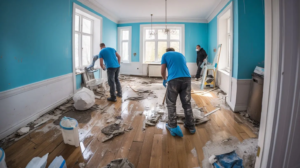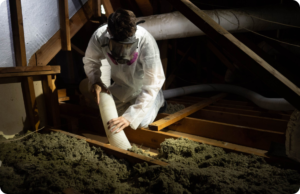Drywall Repair Phoenix is an important service that most homeowners and business owners will need at one time or another. Whether it’s nail pops, cracks, or water damage the previous homeowner overlooked or you have recently noticed, a quality drywall contractor can help.
Small blemishes can be spackled or patched with spackle or joint compound and a putty knife, making them almost invisible when repainting.

Drywall cracks are the small or large fissures that appear in the gypsum board that makes up your home’s walls and ceilings. While some hairline cracks may be nothing to worry about, others can indicate a serious problem with the foundation of your house that needs immediate attention.
Often, drywall cracks are caused by stress from changes in temperature and humidity, which can make the drywall expand and contract, and then eventually crack. Fortunately, there are several ways to fix these cracks and prevent them from coming back.
If the crack is very small (less than 1/8 inch wide) it is probably non-structural and can be fixed using joint compound and drywall tape. Before beginning the repair, clean the area around the crack with a rag and some sandpaper to remove any loose debris. Then, apply a coat of joint compound to the wall and use a putty knife to spread it evenly. Allow the compound to dry completely before sanding. For a quicker repair, you can also use pre-mixed joint compound to avoid mixing it yourself.
For larger or more serious cracks, you will need to re-attach the drywall to the studs. If the crack is at a junction where a drywall panel meets another piece of drywall, first remove the old sheet, then install a new joint. If the crack is along a vertical or horizontal seam, first widen the crack with the corner of a paint scraper or utility knife to reveal the joint.
Once you have removed the damaged panel, use a drywall screw gun to drive screws into the studs on both sides of the crack. Make sure the heads of the screws are not visible above the surface of the drywall, and then cover the screw holes with a thin coat of drywall joint compound.
For larger or more serious cracks, you can attach a new drywall panel to the studs by cutting out a square of drywall along the edge of the cracked wall. Apply a thin coat of joint compound to the back of the new panel, then press it against the wall. Smooth the seam, and then apply a second coat of joint compound over it. For a more professional look, you can use drywall texture to hide the joint compound and provide a smooth surface.
Holes
If you’ve got small holes or nail pops, Silva explains, you can fix them with spackle and a putty knife. To do so, first clean the hole and remove any loose debris. Then measure the hole’s dimensions and cut a piece of drywall that’s larger than the area to be repaired. Now, apply a thin layer of spackle or lightweight joint compound over the entire area with your putty knife. Smooth the spackle or joint compound so that it’s flush with the wall, then let it dry according to the product instructions. Once it’s dry, lightly sand the surface of the drywall to make it smooth and prepare to repaint.
Larger holes in drywall require more time and skill to repair. If you’re not comfortable handling this kind of project yourself, consider bringing in a professional for drywall repair. Depending on the extent of the damage, a pro can help you determine if there are any underlying issues and recommend an appropriate course of action.
Before drilling into drywall, always check to see if there are electrical cords or plumbing lines running behind it. If so, carefully enlarge the hole to avoid cutting into those wires and pipes. It’s also a good idea to use a drill with a rotary motion rather than a straight blade, which can cause more damage.
For a more substantial patch, you’ll need to add a strip of drywall tape to the back of the hole and sand it smooth. Then apply a second thin coat of spackle or lightweight joint compound to fill the hole, using your putty knife to smooth it and feather the edges so that it blends with the surrounding wall. Finally, sand the surface of the patch with a fine-grit sandpaper to prepare it for painting.
For more minor blemishes, like dents, touch-up paint should be sufficient to cover them without drawing attention to the repair work. If you want to repaint the whole wall, however, it’s a good idea to prime the patch first. This will ensure that the new coat of paint doesn’t absorb into the bare drywall and make it stand out.
Water Damage
Water damage can cause many problems for a homeowner, from making walls and ceilings look unsightly to damaging wallboard so much it needs to be replaced. The best way to repair drywall that has been affected by water is to remove the damaged panel and install a new one, but this can be difficult without proper equipment and expertise. If the damage is severe enough, it may be necessary to hire a professional contractor to handle the project.
Before starting the drywall repair process, the first step is to clear away any debris that has been left behind and to make sure the area is completely dry. It can take up to three days for a wet section of drywall to fully dry out. During this time, it is recommended to place an area fan in the room and plug in a dehumidifier near the affected wall. If possible, it is also a good idea to open doors and windows to aid in air circulation.
Next, the damaged drywall must be removed with a utility knife or a saw. Once the old drywall has been removed, a fresh piece must be installed and attached with either drywall tape or mud. It is important to ensure that the new drywall is properly installed and sealed, so it will not be subject to future water damage. Finally, the surface of the drywall should be sanded down and primed before applying a coat of paint.
Once the drywall is repaired and dried, it’s important to address the source of the problem. Fixing any leaks in the roof or plumbing system and taking steps to prevent future flooding should help to prevent further drywall damage.
The key to repairing drywall that has been affected by water damage is to be proactive and act fast. The longer water sits on drywall, the more likely it is to warp or develop mold. Taking steps to prevent future issues can save homeowners a lot of money and headaches in the long run.
Texture
A wall’s texture can help hide imperfections and can also make a patch or other repair stand out. Some textures are hard to match, especially if the tradesman who originally applied the texture didn’t do a good job. In those cases, you might need to practice on some scrap pieces of drywall. With time, though, you can learn to patch and blend textured areas with ease.
Start by applying a skim coat of joint compound to the repaired area, feathering it outward so that it blends with the existing wall surface. Then, let it dry. Apply a second coat, feathering the edges further out. When the area is dry, lightly sand it to smooth any rough areas. Be careful not to sand too much, or you’ll create a noticeable transition between the new and old walls.
For other textures, you may need to do more experimenting before you can match the texture exactly. For instance, knockdown textures can vary widely depending on how heavily the texture was applied and even on how the drywall was hung. Using a hand-held block sander with progressively finer grits of sandpaper should help you remove the excess texture and get a good match for the surrounding wall.
Once you have a satisfactory finish with the sanding and feathering, it’s time to apply the texture. If you’re not sure how to do this, look up videos of professional drywall contractors doing it or ask the contractor that did your work for advice. If you decide to use a reusable texture stencil, be sure to clean it thoroughly after each use and before applying to the next area.
If you’re doing a large area of repair, consider priming the entire wall before you start to give it a consistent appearance and reduce the amount of work required for each retexture. Finally, if you want to paint the repaired area, choose a paint that matches the existing color and texture of the rest of the wall. And be sure to prime the patch again after the paint dries. This will ensure that the paint adheres well and that the patch won’t be visible when you reapply the texture.


